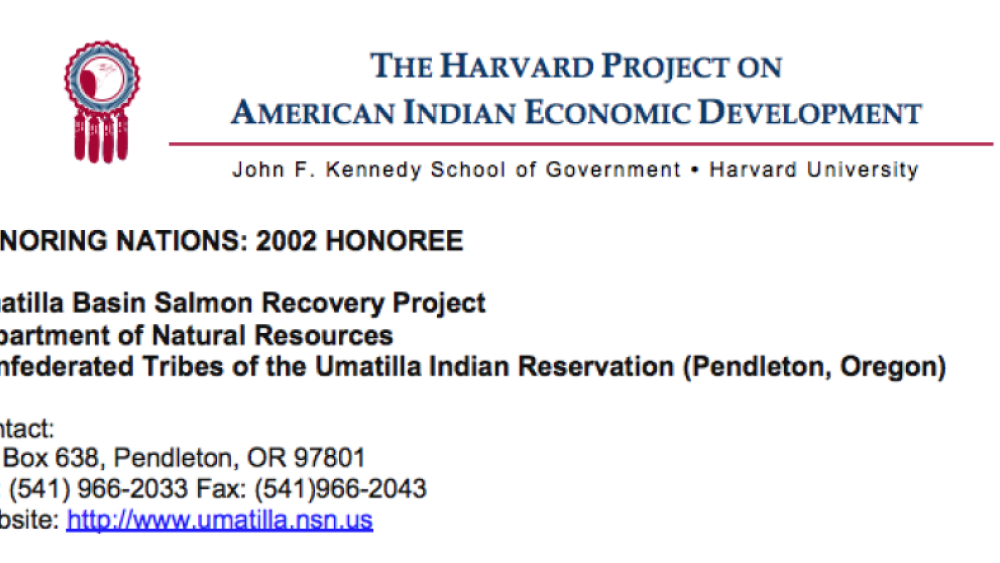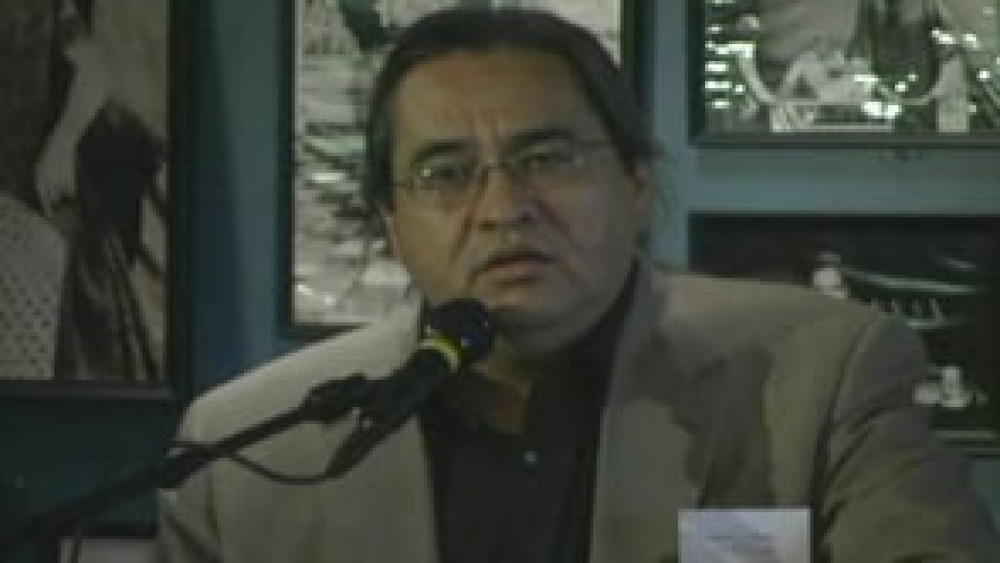Rick George, former Program Manager for Rights Protection and Environmental Planning with the Confederated tribes of the Umatilla Indian Reservation, shares what he sees as the foundational characteristics of the Umatilla Basin Salmon Recovery Project and other examples of successful, sustainable nation-rebuilding initiatives that Umatilla has developed.
Additional Information
George, Rick. "The Umatilla Basin Salmon Recovery Project: Building on Success." Honoring Nations symposium. Harvard Project on American Indian Economic Development, John F. Kennedy School of Government, Harvard University. Cambridge, Massachusetts. September 11, 2004. Presentation.
Transcript
Amy Besaw:
"And next up we have Rick George from the Confederated Tribes of the Umatilla Reservation. Rick is the -- excuse me while I look -- environmental protection and rights protection manager for the nation."
Rick George:
"Good afternoon, everyone. It's a pleasure to be here. It's an honor to be able to speak to you this afternoon. I'm here at the behest of Donald Sampson, he sends his apologies and he also sends me to give them to you. We lost a tribal leader a few weeks ago and he was a very close friend of mine and he was my boss and I want to honor him today with my words.
One of the most important lessons I've taken from these last couple of days -- and I was not prepared for it, it's not something I considered in coming here -- was the lesson from the younger generation. The youth, the young adults, the recognition that this program has given them and the role models that you provide not just your youth but all of us. I applaud that and I think that if there is a standard of measure of success of this Harvard program of honoring nations it is that. It is that you have recognized the younger generation and you have singled them out in a national award recognition program that I think supersedes all of the other recognition processes and programs and things that I'm aware of. And I just hats off to you all. It's been a pleasure, it's been an honor to be here with you for the last couple of days.
And for that reason I just want to say thanks to Harvard and I want to say thanks to Ford and to the Casey foundations. I don't know if you have other supporters, I'm sure you do, but just watching the younger folks here I don't think there's a better way to represent the success of your funding, of your contribution, of your support and of the work of the people that make this program what it is. So thank you very much. And I think when you talk about how to sustain programs, how to make good things continue, that's one of the first things you do, you recognize them. You honor them and you give thanks for them and that's what we're doing and that's what this Harvard program does. So I think that's one of the first key components in maintaining and actually building on successes.
I work for the Confederated Tribes of the Umatilla Indian Reservation, which is located in northeastern Oregon, made up of three tribes, the Walla Walla, the Cayuse and the Umatilla. At one time, prior to treaty, they utilized country that is now part of the southeastern Washington and northeastern Oregon and far beyond that area. The tribe has been honored by the Harvard program, high honors for a project called the Umatilla Basin Project. It's a project that restored stream flows to the river that flows through the heart of the reservation after 70-plus years of having no stream flows for six months out of the year and then putting salmon back in those waters, three different stocks of salmon. The river has gone from dry for six months out of the year for 70-plus years and it has gone from zero salmon for 70-plus years to 30,000 adult salmon returning each year and to a flowing river 12 months out of the year. It was conceived of, negotiated, and implemented by the Confederated Tribes.
The tribe was awarded also high honors for a salmon foundation funding program that's operated by a tribal consortium that includes the Confederated Tribes of the Umatilla, also includes the Yakima, the Nez Pierce and the Warm Springs tribe and that's the Columbia River Intertribal Fish Commission out of Portland. And the tribe received honors recognition for its cultural resources protection program, a program that has just been a phenomenal success on the reservation as far as being a demonstration for Indian people at home and for tribes across the country, and in some cases across the world, for how to protect your cultural artifacts, your sacred places, by doing it yourself, by taking over the expertise, the responsibility and the obligation and taking it away from folks that have been trying to do it for a century and a half.
I think there are several foundational characteristics in addition recognizing and rewarding successful programs that the Umatilla tribes use day in and day out to make sure that successes continue and that they actually grow into new successes. One of those is vision and leadership. And I am fortunate enough today to be here at Harvard with the chairman of the Confederated Tribes, the chairman of the board of trustees, chairman Antone Minthorn. Antone, would you stand up please? [Applause] Chairman Minthorn has been on the board of trustees for 20 years and when you talk about vision and leadership in our country, in our part of the world, Chairman [Antone] Minthorn is the vision and the leadership that has guided the Umatilla Basin Project, the salmon and water restoration project, from start to now. It's his vision, it's his leadership that makes sure that that program is well understood and honored by both tribal people and the off-reservation, non-Indian people. And one of the things you get the opportunity to do when you come back to a program like this is learn from other people. And yesterday during Chairman [Anthony] Pico's moving presentation, Antone looked at me and he elbowed me in the side and he said, 'Now that chairman has a good speech writer.' [Laughter] So I'm going to take that home and I will learn from that.
Vision and leadership -- it is the foundation to make sure that you continue on with your successes and that you honor them as you should. Funding, obviously you've got to have funding and it's got to be stable funding to keep the program going and to allow it to grow and bud off into new successes. I think it's equally important, though, to recognize -- and this tribe recognizes it very well -- that because you may need a quarter of a million dollars to get the project going and implemented, you don't need that much money and you potentially don't need the same staff to keep it going. In fact, it's going to change. Funding levels need to change with that transition and often supervision of the project needs to change, too. Umatilla Basin Project is a good example. Once that was negotiated, congressional legislation passed, funded, implemented, meaning it was constructed and operational, the tribe then transferred it out of the program that I work and into a different program that has the expertise to operate and maintain a project like that. That leaves us available to do different work, to do new work.
Commitment. One of the things that you won't see successful programs without is commitment. If you think about what you've heard today and yesterday from the tribal leaders -- young and a little bit older than that -- one of the things you've heard is that none of these projects were one-year projects. They weren't five-year projects. They were decades-long projects. Commitment from tribal leadership and from the tribal membership is absolutely critical. New successes have to have that same level of commitment. And I think that new successes become easier once you have successes to build on and that level of commitment, that institutional investment that runs from tribal policy down to tribal membership, is easier to come by once you break that barrier of major successes.
One of the things the tribe has been really good at doing is moving off of successes, leaving them where they should be to be implemented, taken care of, nurtured, funded, but then moving the people, the policy priorities, on to new projects and programs to create new successes. In the Umatilla Basin Project, once that project was operational, the tribe immediately stepped over the mountains to the next river which had the same problem, an off-reservation river but a river that the tribe maintains treaty-reserved rights to fish in. Same problems, agricultural diversions dried up the river, it fuels the economy of that river basin, the Walla Walla river basin in Oregon and Washington, and the tribe simply stepped over and used the same model that worked in the Umatilla Basin. And that's not a technical-fix model, that's a 'how do you work with people?' model. It's a sit down with people and negotiate a resolution and then figure out together how to make it happen, how to get the millions, and in this case probably more like $150 or 200 million to make it happen. And the tribe itself coughed up $2.5 million of its own money. First went back to Congress to get a change in the legislation so that they could do that, $2.5 million over the course of the last three years to contribute to the federal agency that's planning and designing the project. So applying successful models: you get one, you move it out, and you do it again. And you continue doing it and you learn every time you do it how to do it better. The Umatilla tribes have just done great work at using that model concept and moving it out.
And lastly, and this may well be the most important component that I know we've learned back home on the Umatilla Indian reservation, and that is you have to have an intimate connection to the Indian people. That's another thing you think about with the projects, the people that you've listened to today, that defines every project I heard was an absolutely intimate connection to Indian people from start to finish. Without that connection to Indian people you will drift and your project won't have that foundation back on the reservation that will allow all the other things to happen, continued funding, continuity of funding, continuity of it being a priority at the political level within tribal governments and that communication connection to tribal people is just absolutely foundational.
And finally, in closing, I want to say that Chairman Minthorn came out here for whatever reason, his administrative staff at home must have told him that he was going to speak so he has a wonderful speech prepared, he's wanting to give it so give him a call back home and I'm sure that he will give you his speech over the telephone [Laughter]. We can do a conference call; it's a wonderful speech. Not as good as what we heard yesterday, but it ranks right up there.
I want to say thank you and I want to say that this two days has been very, very instructive for myself. We have learned things that we'll take back to the reservation and we're very eager to continue to work with you all and to be in the presence of, as was said by the speaker before me, the elite of tribal leadership and tribal people. Thank you very much."



